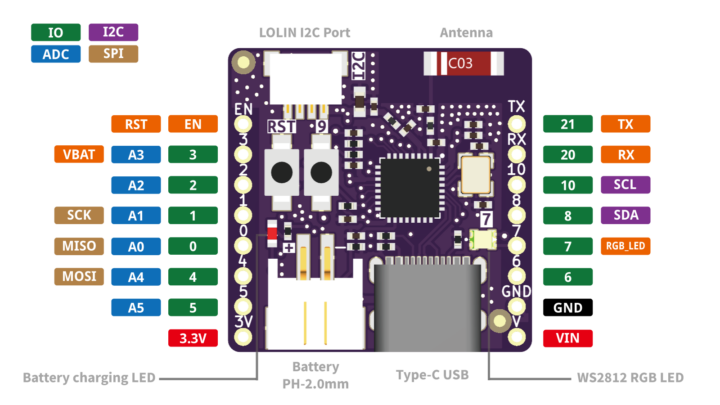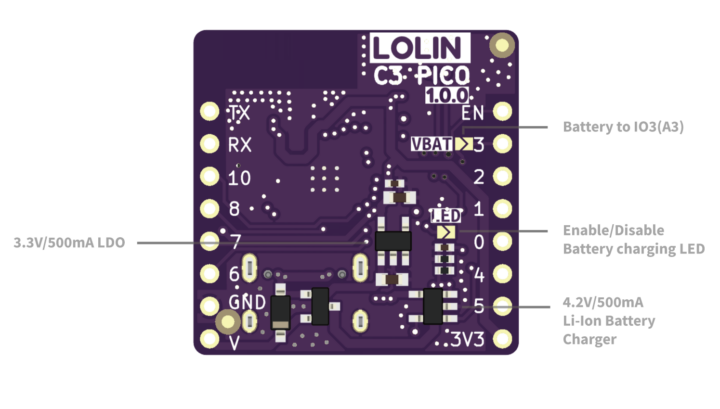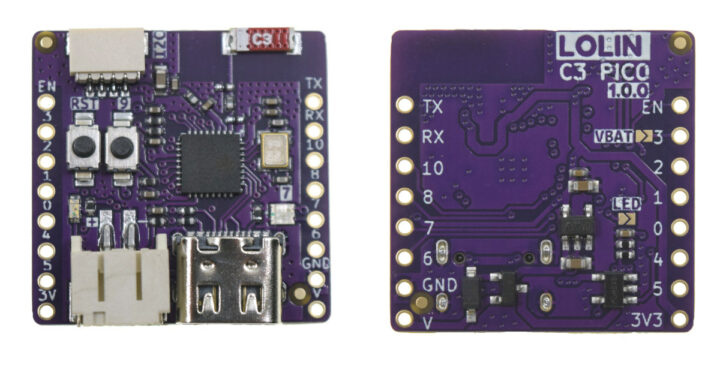LOLIN C3 Pico is a tiny (25.4×25.4mm) ESP32-C3 RISC-V board with 2.4 GHz WiFi and Bluetooth Low Energy connectivity, a few I/Os, and LiPo battery support including charging circuitry.
I tend to like Wemos/LOLIN boards, because of their small form factor, support for equally tiny shields, and low price. The LOLIN C3 Pico is no exception, and even adds a few features such as an RGB LED, an I2C connector, and support for battery power and charging.
LOLIN C3 Pico specifications:
- SoC – Espressif Systems ESP32-C3FH4 single-core 32-bit RISC-V (RV32IMC) microcontroller up to 160 MHz with 400 KB SRAM, 4MB Flash
- Connectivity – 2.4 GHz WiFi 4 and Bluetooth 5.0 LE (in SoC)
- Expansion headers
- 2x 8-pin headers with up to 12x GPIO, ADC, I2C, SPI, UART (3.3V I/O voltage)
- LOLIN I2C port
- USB – 1x Type-C USB for 5V power and programming
- Misc – Reset button and user button, RGB LED
- Power Supply
- 5V via USB-C port or VIN pin
- 2-pin JST connector for LiPo battery and 500mA charging support
- Dimensions – 25.4 x 25.4 mm
- Weight – 2.6 grams


The board ships with MicroPython firmware, but also support Arduino, CircuitPython, and ESP-IDF programming. Documentation and basic instructions to get started can be found on the wiki.
What’s interesting is that the LOLIN C3 Pico is a smaller version of the LOLIN C3 Mini introduced in Q1 2022 with all the same features, but adding battery support, an I2C connector (Qwicc compatible?), and an RGB LED. This was partially achieved by replacing the PCB antenna with a more compact ceramic antenna.
The main downside compared to the C3 Mini is the price with the LOLIN C3 Pico going for $5.00 plus shipping, and the previous board is usually sold for $4.10. However, they must be getting rid of existing stock with the LOLIN C3 Mini board being offered for just $2.50 plus shipping (or $2.78 in total to Thailand). $5 also happen to be the price for the even smaller XIAO ESP32C3 board with similar features as the LOLIN C3 Pico, but two fewer I/Os, and an external antenna.

Jean-Luc started CNX Software in 2010 as a part-time endeavor, before quitting his job as a software engineering manager, and starting to write daily news, and reviews full time later in 2011.
Support CNX Software! Donate via cryptocurrencies, become a Patron on Patreon, or purchase goods on Amazon or Aliexpress





